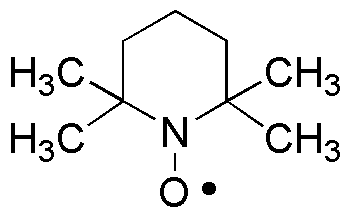2,2,6,6-Tetramethyl-1-piperidinyloxy, free radical is widely utilized in research focused on:
- Antioxidant Studies: This compound serves as a stable free radical, making it an excellent model for studying antioxidant mechanisms in biological systems. Researchers can explore how it interacts with other radicals and its potential protective effects against oxidative stress.
- Polymer Chemistry: It is used as a radical initiator in polymerization processes, particularly in the production of thermoplastic elastomers. Its stability allows for controlled polymer growth, leading to materials with desirable properties.
- Medicinal Chemistry: The compound is investigated for its potential in drug development, particularly in creating novel therapeutic agents that target oxidative stress-related diseases, such as neurodegenerative disorders.
- Material Science: It finds applications in the formulation of advanced materials, including coatings and adhesives, where its radical properties can enhance durability and performance.
- Food Preservation: Researchers explore its use in food science as a natural preservative, leveraging its antioxidant properties to extend shelf life and maintain food quality.
Informations générales
Propriétés
Sécurité et réglementation
Applications
2,2,6,6-Tetramethyl-1-piperidinyloxy, free radical is widely utilized in research focused on:
- Antioxidant Studies: This compound serves as a stable free radical, making it an excellent model for studying antioxidant mechanisms in biological systems. Researchers can explore how it interacts with other radicals and its potential protective effects against oxidative stress.
- Polymer Chemistry: It is used as a radical initiator in polymerization processes, particularly in the production of thermoplastic elastomers. Its stability allows for controlled polymer growth, leading to materials with desirable properties.
- Medicinal Chemistry: The compound is investigated for its potential in drug development, particularly in creating novel therapeutic agents that target oxidative stress-related diseases, such as neurodegenerative disorders.
- Material Science: It finds applications in the formulation of advanced materials, including coatings and adhesives, where its radical properties can enhance durability and performance.
- Food Preservation: Researchers explore its use in food science as a natural preservative, leveraging its antioxidant properties to extend shelf life and maintain food quality.
Documents
Fiches de données de sécurité (FDS)
La FDS fournit des informations de sécurité complètes sur la manipulation, le stockage et l’élimination du produit.
Spécifications du produit (PS)
Le PS fournit une description complète des propriétés du produit, notamment sa composition chimique, son état physique, sa pureté et les exigences de stockage. Il détaille également les plages de qualité acceptables et les applications prévues du produit.
Certificats d'analyse (COA)
Recherchez des certificats d'analyse (COA) en saisissant le numéro de lot du produit. Les numéros de lot et de lot se trouvent sur l'étiquette d'un produit, après les mots « Lot » ou « Lot de fabrication ».
Numéro de catalogue
Numéro de lot/série
Certificats d'origine (COO)
Ce certificat d'exploitation confirme le pays dans lequel le produit a été fabriqué, et détaille également les matériaux et composants utilisés et s'il est issu de sources naturelles, synthétiques ou autres sources spécifiques. Ce certificat peut être requis pour les douanes, le commerce et la conformité réglementaire.
Numéro de catalogue
Numéro de lot/série
Fiches de données de sécurité (FDS)
La FDS fournit des informations de sécurité complètes sur la manipulation, le stockage et l’élimination du produit.
DownloadSpécifications du produit (PS)
Le PS fournit une description complète des propriétés du produit, notamment sa composition chimique, son état physique, sa pureté et les exigences de stockage. Il détaille également les plages de qualité acceptables et les applications prévues du produit.
DownloadCertificats d'analyse (COA)
Recherchez des certificats d'analyse (COA) en saisissant le numéro de lot du produit. Les numéros de lot et de lot se trouvent sur l'étiquette d'un produit, après les mots « Lot » ou « Lot de fabrication ».
Numéro de catalogue
Numéro de lot/série
Certificats d'origine (COO)
Ce certificat d'exploitation confirme le pays dans lequel le produit a été fabriqué, et détaille également les matériaux et composants utilisés et s'il est issu de sources naturelles, synthétiques ou autres sources spécifiques. Ce certificat peut être requis pour les douanes, le commerce et la conformité réglementaire.


